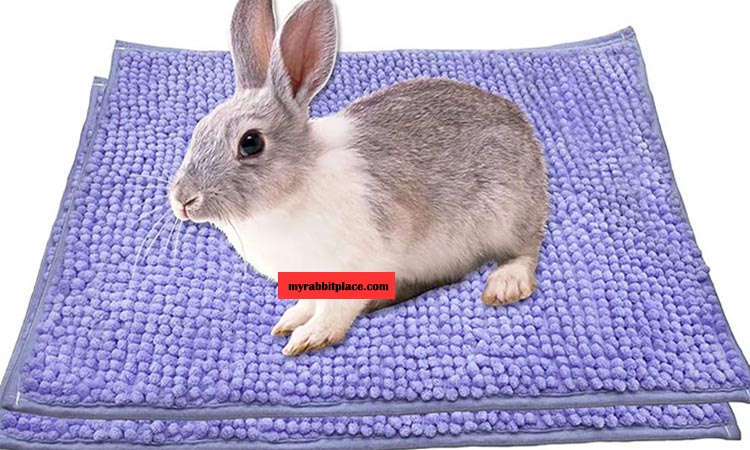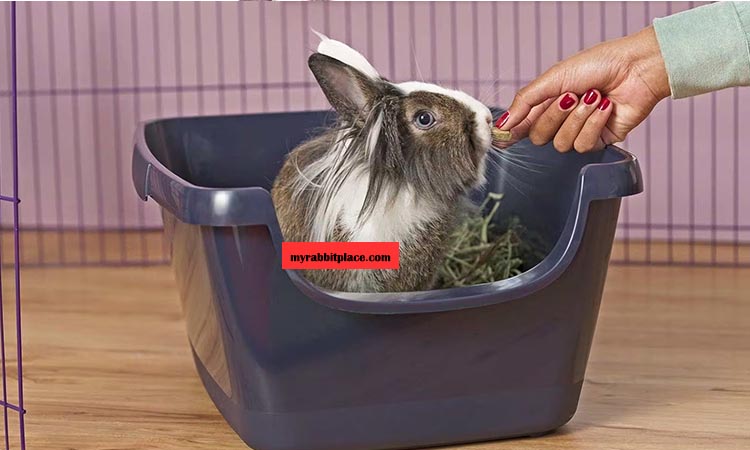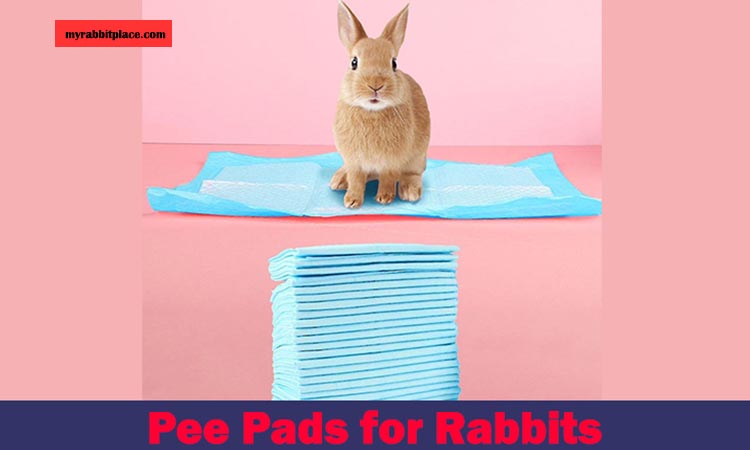Pee pads are those mats you often see in homes that have pet animals. They are great for catching pet pee, especially if you are busy or can’t always take your pet outside. They make cleaning up quick and easy and give your pet a designated spot to go to the bathroom indoors.
If you are a rabbit owner then you might think, can rabbits use pee pads like other pets? It’s not a simple yes or no. While some rabbits might get the hang of it, there are important things to think about, like their health and natural habits.
In our complete guide, “Pee Pads for Rabbits: A Complete Guide,” we will talk all about using pee pads with rabbits. We will look at the good and bad sides, talk about staying safe, and give other ideas for teaching your rabbit to use a litter box.
Can Rabbits Be Trained to Use Pee Pads?
Yes, rabbits can be trained to use pee pads, but there are some things to consider. Rabbits, like lots of animals, like having specific places to go to the bathroom. They can be trained to use a litter box because of this natural habit.
Pee pads work with this behavior, but there are limits, which we’ll talk about in this blog. We will look at the good and bad sides of using pee pads with rabbits, talk about staying safe, and help you find the best way to potty train your rabbit.
Drawbacks of Pee Pads for Rabbits
Pee pads seem handy for pet toileting, but they are not the best for rabbits. Let’s see some of the drawbacks of pee pads:

Unnatural Behavior
Rabbits love to dig, it’s a natural instinct. In the wild, they dig burrows to stay safe and cool. But pee pads don’t let them dig because they are flat and have absorbent materials like hay. This might make your bunny frustrated, and they might start digging in places they shouldn’t, like your carpet.
Chewing Hazard
To a curious rabbit, pee pads may appear delectable due to their absorbent materials. Cross your fingers that the rabbit you keep might not eat them otherwise, it will be too late for you to know. Ingesting pee pad material can cause stomach blockages which could make your bunny very unwell. Therefore, it is of paramount importance that you ensure such pads are kept away from bunnies.
Unsanitary Environment
Pee pads soak up urine much more quickly as compared to boxes with cat litter that have to be changed frequently. They become a place for bacteria and ammonia to thrive in large numbers. It smells terrible, and neither you nor your rabbit should have anything to do with it.
Limited Success
Using pee pads with rabbits may not always work out so well. There can be times when rabbits still pee even around areas where pee pads are located. This is annoying to the owner of the pet and makes toilet training more difficult than it ought to be.
Also Read - 10 Signs of a Happy Rabbit
Advantages of Using Pee Pads for Rabbits
Compared to litter boxes, there are only a few real benefits in using pee pads for rabbits. There can be some potential upsides such as:
Potential Convenience
In particular instances, pee pads may be a stopgap solution. For instance, when you go on a journey with your rabbit for just a little bit and cannot carry along the litter box, you might want to have that pee pad as an alternative. However, bear in mind that it’s not the best option and should only be used briefly.
Easier Cleanup
Pee pads are supposed to make cleaning up accidents easier because they soak up pee. But sometimes, accidents can happen outside the pad area, and you have to change the pad often. This can make cleaning up just as tricky as scooping litter.
Safety Considerations When Using Pee Pads
If you want to use pee pads for your rabbit, it is essential that you consider safety. First, buy unscented pee pads because rabbit’s are sensitive to smells.
The next thing is keeping the pad in place so that your rabbit doesn’t chew it. Put anything heavy on top of the mat or use a litter box with wire mesh bottom.
Lastly, make sure to keep changing the pad frequently so as to keep your bunny’s area clean and reduce dangerous bacteria and ammonia buildup. Also pay close attention when your pet is urinating on mats, if he/she starts chewing on it take away instantly to avoid swallowing something harmful.
Alternatives to Pee Pads
Instead of using pee pads, you could train your rabbit to use a litter box. This is the safest and the most natural way of doing it. The following are two ways that work in conjunction with the instincts of your rabbits;
Traditional Litter Box: A traditional litter box filled with pellet litter and topped with hay is what works best for most rabbits. Make sure that the box is large enough to make your rabbit move easily. Rabbits naturally go to the bathroom where they eat, so it’s important to put plenty of hay on top; this gives them something nice to dig into. This environment satisfies their instinctive digging desires while at the same time encouraging their bunny towards its use.
Hay-Only Litter Box: For bunnies that prefer this type of toileting method, a hay-only litter box can be a good choice too. It allows them to defecate within hays; an area where they are used to doing it in nature. A box almost similar in size as mentioned before would suffice if entirely filled with only hay. Although this means frequent cleaning, any potential health risks from certain types of litter would be eliminated through such an arrangement.
Be consistent if you want your rabbit to use the litter box successfully. Keep the container clean, put plenty of hay into it and reward your pet with praise or treats whenever they go inside. Give it time and a good set up, so that your bunny rabbit can form a hygiene habit quickly.
Tips for Successful Litter Box Training
To effectively teach your rabbit to use the toilet, there are some important points to remember. One is that you should put the litter box in a corner away from their feeding as well as drinking bowls which will provide them a comfortable private area.

A big enough litter box must be selected so that the rabbit has space to move around in otherwise cramped quarters may discourage its use. Being naturally tidy animals, rabbits require an organized environment; therefore make sure you scoop out droppings on daily basis and change the entire bedding once every seven days in order to maintain freshness, thus prompting them effectively towards using their toilet place.
Moreover, training also involves positive reinforcement, therefore kindly give your rabbit some snacks or praise for using the litter box correctly, thus associating this behavior with a good feeling. Thus, doing this consistently will help your rabbit establish a successful and happy schedule when it comes to the bathroom.
FAQ
What are the drawbacks of using pee pads for rabbits?
Firstly, rabbits have a natural digging instinct; however, pee pads cannot be used as a digging surface. Additionally, they can be chewed and cause gastrointestinal obstructions in these animals. The frequent changing of such items is necessary because they get dirty fast but some bunnies use them only once or twice hence making them have accidents elsewhere.
Are there any advantages to using pee pads for rabbits?
For instance, in situations where a litter box is not feasible such as during short travel periods, there might be temporal convenience offered by pee pads. This is nevertheless less than perfect and should not be relied on permanently.
If I use pee pads, what safety precautions should I take?
Use unperfumed pads, secure the pad against chewing, change them often and watch out for any chew marks. Consider litter boxes as being more dangerous generally.
What are some safer alternatives to pee pads?
The standard litter boxes with shallow layer of recommended pellet litter topped with hay work well. Rabbits like to go where they eat so just use hay on its own in the box. This way it looks like their natural environment.
How can I successfully litter box train my rabbit?
Put the litter box in a quiet corner away from feeding and watering areas. Selecting an adequately large container and doing daily scoops while changing beddings weekly helps keep them clean. When your pet uses the toilet, reward it with positive words or treats
My rabbit isn’t using the litter box consistently. What should I do?
Check again where you put it, if it is big enough, and how clean it is. It’s important also that you have right bedding materials such as hay and litters.
If there are no underlying medical issues consult your veterinary doctor about this matter. Training rabbits on how to adapt requires time hence you need patience.
Conclusion
Using litter boxes is the best way to train your rabbit to go to the bathroom. They match your rabbit’s natural habits, keep your home cleaner, and are more dependable.
With some planning, patience, and the right setup, you can make a routine that works well for your bunny and keeps your house tidy. A litter box filled with hay isn’t just a bathroom for your rabbit; it’s also a fun place for them to dig and feel comfy while they do their business.


